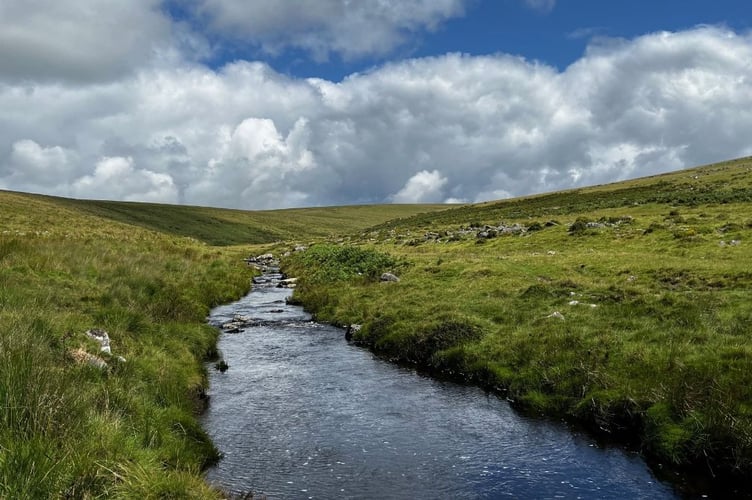TWO enormous nature recovery projects on Dartmoor have have been successful in becoming part of the Government's Landscape Nature Recovery Scheme.
The scheme, which includes millions of pounds of funding, was announced by Defra last week ahead of COP28.
Walkham Valley and Central Dartmoor Farm Cluster announced as Landscape Recovery Areas in national package benefiting nature and sustainable farming Both focus on enhancing nature across Dartmoor’s farmland, moorland and wooded valleys in a manner that aids farm business resilience
They will collaborate with the existing East Dartmoor Landscape Recovery area, demonstrating the commitment and collective to deliver landscape-scale benefits for nature, farming, economy and climate.
Farmers and landowners are working on ambitious plans to boost nature and strengthen farming resilience across huge parts of Dartmoor National Park.
The Walkham Valley in West Dartmoor and Central Dartmoor Farm Cluster were two of the 34 successful bids in the second round of the Government’s Landscape Recovery scheme, announced last week by Defra ahead of COP28.
Both schemes will work with each other and the existing East Dartmoor Landscape Recovery Area led by Devon Wildlife Trust.
This shared ambition to help create large-scale, connected nature recovery areas has the power to transform the ecological landscape of Dartmoor National Park and bring about a wealth of public goods.
About Landscape Recovery schemes Landscape Recovery is a key component of the Government’s Environmental Land Management scheme. It is for farmers and land managers who want to explore large-scale, long-term and coordinated approaches to producing environmental and climate goods on their land. It funds ambitious landscape-scale projects through bespoke, long-term agreements. The aim is to deliver a range of positive environmental and social benefits while meeting local and national ambitions. This includes those in the Dartmoor Partnership Plan, the 25-Year Environment Plan and the Green Finance Strategy alongside Defra's commitments to protect a minimum of 30% of land by 2030. What the schemes will do

The overall aim is to develop solutions that enhance nature – such as creating new or improving existing habitats and biodiversity - while exploring innovative ways to build business resilience.
The restoration of natural processes plays a vital role. For example, restoring damaged peat and soil supports carbon capture, provides clean water and promotes better grass and crop growth. Work to limit the slow and flow of water reduces the risk of flooding – in this case to communities such as Walkhampton and Horrabridge – and protects against the erosion or washing out of important historic features.
Agriculture continues to shape Dartmoor’s landscape, as it has done for thousands of years. Grazing animals play an important role in habitat management alongside food production. Both schemes will look at farming economics and business resilience and explore innovative approaches to animal husbandry and regenerative farming techniques, as examples.
Along the way, there will be public engagement and learning opportunities.
Dartmoor National Park Authority Chair Pamela Woods said: 'This is an excellent opportunity for us all to build on the excellent nature enhancement work achieved so far. With the increasing pressures facing the environment, it’s vital that we all work collaboratively to safeguard and enhance nature by working at scale.
'The farmers and landowners involved bring exceptional knowledge, skills and expertise to the table having farmed or worked on Dartmoor for generations. These schemes provide an excellent opportunity to help enable those invested to look holistically at a whole landscape and collectively design and deliver solutions that will safeguard the future of the National Park more widely.' The Walkham Valley Landscape Recovery Area
With its tor-topped moorland, blanket bog, wooded valleys, enclosed farmland and stunning historic features, the Walkham Valley is a remarkable example of Dartmoor’s mosaic landscape formed over thousands of years.
The scheme focuses on the catchment of the River Walkham, an area of 15sq miles, boasting internationally important archaeology and priority species such as the Blue Ground Beetle, Marsh Fritillary and Atlantic Salmon, Sites of Special Scientific Interest and Special Conservation Areas.
Dartmoor National Park Authority is co-ordinating the scheme with support from participating farmers, landowners and the Dartmoor Hill Farm Project. In recognition of the critical role they play in landscape outcomes, the scheme will be farmer-led.
The Central Dartmoor Farm Cluster The Central Dartmoor Farm Cluster has worked with the Duchy of Cornwall and other landowners to develop a proposal covering 90 square miles – around 25% of the National Park. The project area takes in much of the high moor where many of Devon’s rivers rise, six commons, 40 farms and more than 200 Scheduled Ancient Monuments. The Cluster, working with the Duchy and other landowners, will build on previous work to collaborate with farmers on ideas that enhance farm business resilience and improve habitats while balancing other - sometimes competing – priorities such as conservation, food production, recreation and military use. Central Dartmoor Farm Cluster Chair John Dracup said: 'This is an innovative approach to conservation management, working from the ground up. We want to bring together farmers, landowners, conservationists and people with a love for Dartmoor to make it better for nature and people, more resilient to climate change, while still producing high quality food and building more resilient food and farming businesses.' Land Steward for the Duchy of Cornwall Tom Stratton said: “The Duchy is delighted to have been able to support the Farmer Cluster’s bid which covers almost the entirety of our Dartmoor Estate and to be engaged in the discussions associated with the Walkham Valley bid. 'The outcome reflects the success of a bottom-up approach with farmers and landowners at the heart to identify, with partners, a long-term strategy for the economic and environmental sustainability of the area.' Schemes have a two-year development phase ahead of 20-year delivery period, allowing time to explore and negotiate options resulting in a collective agreement unique to each individual landscape.



